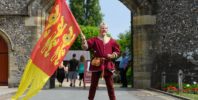
Pauline Moore, East Anglia resident and author of the new historical fiction novel “Brightfire: A Tale of Suttion Hoo,” has recently written the following article looking at the rich Anglo-Saxon history of East Anglia and why it’s a great place for tourism
I realise that many people in the world (including some in Britain!) don’t know much about East Anglia, where I live. It is the big round bulge on the eastern coast.
Back in the 5th/6th centuries Angles and Saxons were moving across the North Sea, even while the Romans were still occupying Britain. When the Roman army left in 410 AD, the place was really open to incomers.
Fertile river valleys, heathland for grazing animals, a dozen rivers for traffic, fishing and easy access to the coast, forests where pigs could forage… All of these offered good areas for settlement. Over time, tribal groups could coexist, amalgamate, and develop areas of power.
By the time he died in 625AD, King Raedwald had consolidated his great kingdom of the Eastern Angles, who lived in what we now see as the counties of Suffolk, Norfolk, parts of fenland Lincolnshire and part of eastern Cambridgeshire.
This landscape (and it’s not all flat!) still basically exists. Norfolk boasts its Broads – lakes and waterways. Inland Suffolk has ‘Brecks’: ancient managed open forest. Our modern forests are usually managed- and obviously settlement has developed into ports, villages, towns, cities – even racecourses! The very first town, a market-site or ‘wick’ grew up in the 7th century: Gippeswick (now Ipswich). Now we can also offer the beautiful and historic city of Norwich; the tiny, lovely city of Ely; the gracious Bury St. Edmunds. All these have glorious cathedrals.
Later history will bring castles, such as the one in the small coastal village of Orford, or in Framlingham, and in Norwich – to name but three. There are also splendid mansions: Halls at Blickling, Houghton, Holkham, Oxburgh, Feltwell, Kentwell, Christchurch in Ipswich etc. Some are owned by the National Trust, others owned privately but are opened to the public.
The coastline is dotted with intriguing villages, resorts, and ports large and small – all very different in character. Gt. Yarmouth, Lowestoft, Felixstowe are the largest; Southwold, Cromer and Sheringham are picturesque. There are small – even tiny ones like Aldeburgh, Brancaster or Shingle Street. Some still make a living from the sea with fishing boats, trans-oceanic ferries or huge container ships.
People who visit the great Anglo-Saxon site at Sutton Hoo, where I am a volunteer guide, often tell me how surprised and delighted they are by the variety of landscape they find – farmland, forest, equestrian centres, coastal paths, urban centres, old churches, modern shopping malls: all within easy touch. Excellent pubs,too: try Ramsholt!
Highlights for visitors include Sutton Hoo, Constable country (Flatford and Dedham – home to the great artist); beautiful medieval places like Lavenham or Woodbridge – where there is a working tide mill; and the North Norfolk coast, with flint-walled cottages.
For residents there are churches, universities, good schools, opportunities for jobs in engineering, communications, overseas trade, tourism, education and agriculture. There are good sports teams, and the Silverstone motor-track, as well as centres for gymnastics, tennis and swimming, and a host of other sports.
East Anglia was a great place for the Anglo-Saxons – and it is for me!





